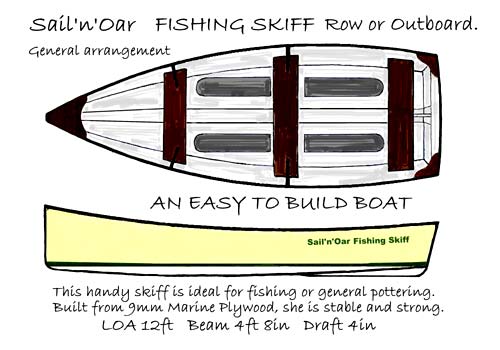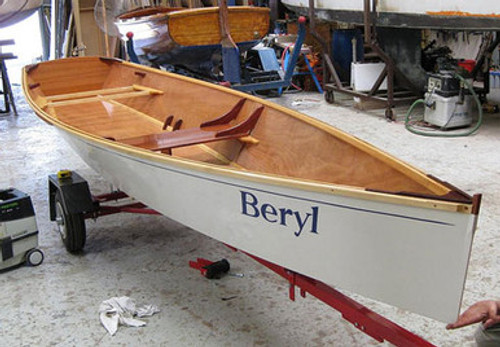Click HERE for digital download for these plans
A small flat iron skiff for sail, oar or small outboard
These plans consist of 60 pages of instructions, diagrams and photos. You have two options for purchase. You can order a printed version that is spiral bound and laminated in order to protect the pages from the usual workshop spills and dust. Or you can save money and buy the instant download which you can print yourself.
More information below. Download a study plan HERE.
INTRODUCTION TO THE SAIL-n-OAR "FLATTIE" - Designed by John Sheen.
Developed from the small boats used around the world for creek and estuary fishing, the flattie dinghy has a reputation for stability, load carrying and handiness.
The Sail-n-Oar Flattie not only derives its name from being of a type of flat bottomed craft, sometimes called skiffs or sharpies, but from the use to which many of the original boats were put locally, fishing for flounders, plaice and dabs, known as "Flatties".
From these humble beginnings the Sail-n-Oar Flattie has developed into a handsome general purpose craft, having an excellent sailing performance with her balanced lug-sail. She rows well with little effort, and can be powered with an outboard motor. She has adequate built-in buoyancy.
The Sail-n-Oar Flattie is a safe family boat which is easily built with very few tools by anyone with basic DIY skills.
Constructed of marine plywood, epoxy resin and glass cloth, she is a strong but light boat, easily handled both afloat and ashore.
The Sail-n-Oar Flattie not only derives its name from being of a type of flat bottomed craft, sometimes called skiffs or sharpies, but from the use to which many of the original boats were put locally, fishing for flounders, plaice and dabs, known as "Flatties".

From these humble beginnings the Sail-n-Oar Flattie has developed into a handsome general purpose craft, having an excellent sailing performance with her balanced lug-sail. She rows well with little effort, and can be powered with an outboard motor. She has adequate built-in buoyancy.
The Sail-n-Oar Flattie is a safe family boat which is easily built with very few tools by anyone with basic DIY skills.
Constructed of marine plywood, epoxy resin and glass cloth, she is a strong but light boat, easily handled both afloat and ashore.
The FLATTIE is a versatile design suited to many uses.







